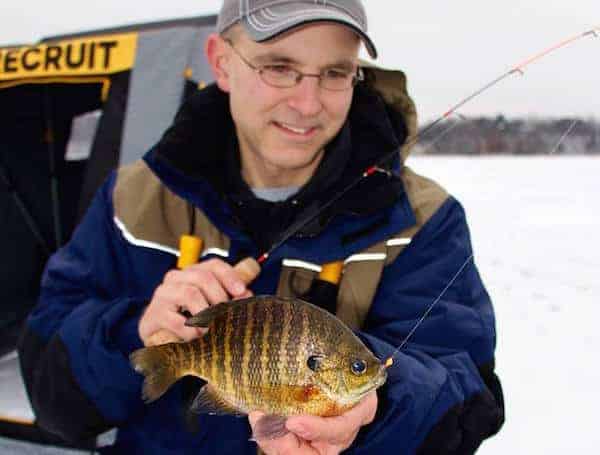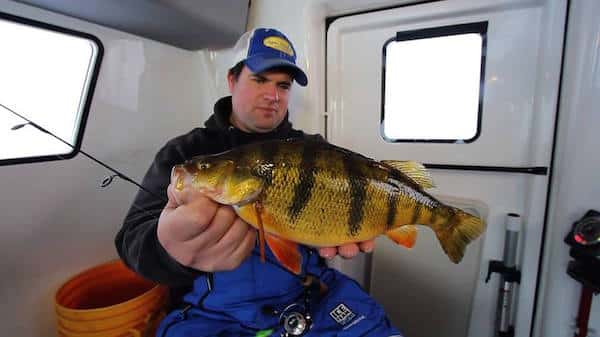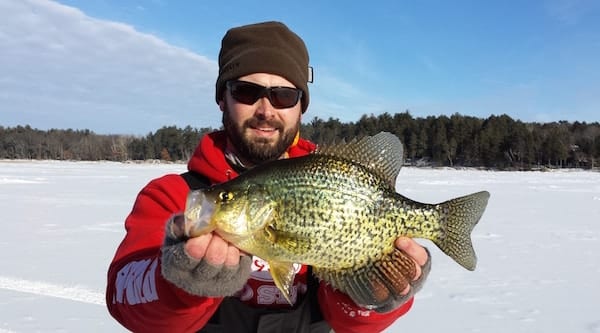Finding late ice panfish begs the question: “Where have they gone and how can I find them?” Luckily for you, we have reached out to some of the top pros across the ice belt to help you tackle this exact problem. We asked them one simple question:
What’s the biggest key to finding late ice panfish?

Brian Brosdahl – Bro’s Guide Service
The key to finding panfish in the late ice period is checking the areas between their wintering holes and the shallow weed beds that they inhabit in spring. In some lakes, the weeds will be dead and gone, but there’s still stubble for the fish to hang around.
As far as transition areas go, you might find fish on in-between flats where they can graze on bloodworms. They could be on various forms of structure including old river channels. Late winter panfish prefer muddy areas, not hard bottom areas for the most part, and river channels provide that in spades. Sometimes panfish head straight up into the weed bed or they will be on the flats near or adjacent to the weed beds. Even fish that are in 20-40 feet of water will eventually move up into the weeds because the thaw freshens those areas, and that’s where they will stay until the next cold front chases them out.

Gord Pyzer – Fishing Editor & Biologist
Wow, so many things to consider to answer that question. One major consideration, though, is the lake type. Small lakes often experience major oxygen depletion near the bottom which causes the fish to suspend. This is particularly the case if you have lots of snow cover. The very best late ice crappie bite I ever experienced was on a eutrophic lake like this that loses oxygen at the bottom. The fish were in 15 feet over 32 feet and stuck out like sore thumbs on the sonar. I fished a 1/4 ounce Williams Wabler lure and the crappies went berserk the moment the spoon cleared the bottom of my hole. I mean, I had two or three at a time racing up to nail it.
Anglers need to remember that the oxygen declines from the bottom up, so the bottom quarter to half of the lake may be inhospitable, but the top half is perfectly fine. In fact, I specifically look for these lakes because I know where the fish will be, and where I don’t need to waste my time looking. They’ll also come much shallower than many anglers imagine.

Jason Halfen – The Technological Angler
My late ice panfish hunts focus on the entrances to shallow bays, particularly where those bays meet the deeper basin of the lake. Panfish that have overwintered in the basin will transition towards these shallow bays while ice still covers the lake, hanging on distinct breaklines separating the basin from the bays. If remnant green weeds are scattered along the breakline, they will concentrate panfish all the way through the late ice period.

Jason Mitchell – Jason Mitchell Outdoors
The first step is finding and focusing on lakes with the biggest panfish, everything else is easy after that. I love the first good break at the mouth of bays. I like that sharp break as I believe a lot of panfish stack up in those spots at late ice in anticipation of moving up into those bays to spawn. Towards the very end, you will often find them up in the shallow bays running the shallow flats, particularly if there are weeds or bull rushes. The break should have a soft bottom and weeds, though that is not always necessary.
The best strategy for catching big fish is often finding the most fish and seeing if you can fish high enough above the school to sort them out from the pack. The bigger panfish are usually more comfortable leaving the pack and will reach up higher to eat if the weather is stable and the fish are in a positive mood.

Jeremy Smith – Angling Edge TV
From my experience weedlines and weed flats are the best places to look for pans late ice. Many times, the basin crappie bite disappears late ice and you can find both crappies and gills in the weeds. Also, this time of year a lot of the fish you catch are very high in the water, sometimes just a foot or two under the ice. When you contact fish, drill lots of holes in that area and just keep bouncing hole to hole. The fish let you know when they’re there and if it’s worth spending a lot of time in one hole.









